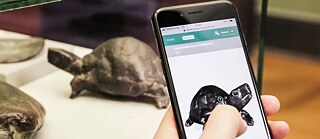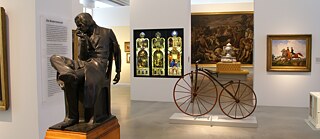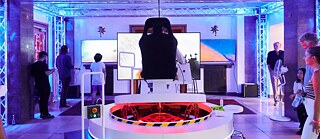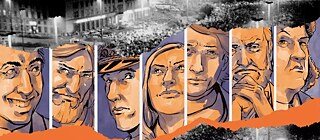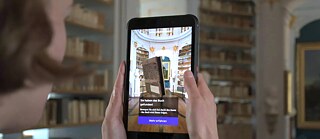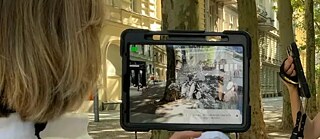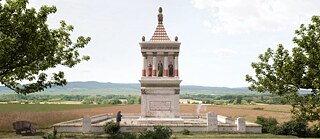Cultural heritage
German Museums Go Virtual

In the past, whenever cultural heritage was destroyed by natural disasters or wars, that destruction was irremediable. But it doesn’t have to be that way anymore: here’s how digital technologies can preserve cultural heritage for posterity.
What do the Church of the Nativity in Bethlehem, Vienna’s Old Town and the Baden State Library’s collection of manuscripts have in common? They’re all forms of cultural heritage that are at risk of degradation, even destruction. Many one-of-a-kind works of art and architecture and other important artefacts of human culture are threatened by environmental impacts, natural disasters and wars as well as illicit trafficking. They could irretrievably vanish from one moment to the next.
However, only between 30 and 50 per cent of Europe’s cultural heritage collections have been digitized to date. This percentage is even lower for landscapes and landmarks such as old towns and archaeological excavations, some of which are also counted as forms of cultural heritage. Digitizing cultural objects means putting works of art, for example, in the virtual realm for preservation and research purposes. The digital tools involved range from knowledge bases and data bases to VR simulations of whole exhibitions and three-dimensional representations of buildings. So now, if a work of art that’s been digitized gets destroyed, it can live on in the virtual world.
Digital twin museums
But digitization serves other purposes too. For one thing, technology applications can be used to make works of art more accessible. So many museums in Germany are digitizing their cultural objects despite the considerable technical and personnel challenges involved. About thirty museums around the country are now working on digital approaches to cultural education in Museum4punkt0, a project launched in 2017: they are developing, testing and evaluating ways of using various digital applications with a view to integrating them into the day-to-day workings of museums. Some museums’ exhibitions, for instance, can now be experienced online by visiting their “digital twins”.
The Germanisches Nationalmuseum in Nuremberg, for example, the largest cultural history museum in the German-speaking world, has teamed up with Acameo, a Tübingen-based start-up, to develop virtual tours of a half-dozen of its permanent exhibitions. The section of the building in which these permanent collections are displayed is soon closing for a years-long renovation; the existing exhibitions will be taken down and reopened afterwards with a new concept. But the original exhibitions will remain accessible and viewable in the virtual world even if they no longer exist in the physical world.
“A digital twin is basically a simple and yet sophisticated way for forward-looking museums to provide virtual experiences of their institution and interesting sites in 3D Web, Virtual Reality and Augmented Reality” explains art historian Frank Dürr, Acameo’s managing director. “Based on LiDAR scans, interfaces and media, a digital twin provides a spectacular foundation for custodial collecting, curated experiences and buzzworthy Extended Reality enhancements.”
Take off with Otto Lilienthal
The Deutsches Museum in Munich, one of the largest science and technology museums in the world, has a digital twin too. “We scanned the Deutsches Museum using a three-dimensional laser scanner and simultaneously filmed it on several 360-degree cameras,” recounts historian of science Maximilian Reimann, a member of the “Deutsches Museum Digital” team. “Then we pieced the data together on the computer to create a virtual 3D model of the Deutsches Museum that’s accurate to the nearest centimetre. So you can still see what the historical Deutsches Museum was like before its modernization, including highlights like the mining exhibition, even while much of the museum is closed.”
Visitors to the Deutsches Museum’s VR Lab can now don Virtual Reality glasses to embark on a virtual experience of Deutsches Museum exhibits. Reimann cites some exciting highlights: “How does the Sulzer brothers’ precision valve steam engine actually work? How did Otto Lilienthal take off from Fliegeberg [the artificial hill he built in Berlin] in his Lilienthal glider? You can help Berta Benz assemble the Patent Motor Car or explore the surface of the moon in a lunar rover using our driving simulator.”
Another important objective of digitizing cultural heritage is to make information more accessible. On the Deutsches Museum Digital website, items from the museum’s collection of objects and from its archives and library are digitally interlinked to show the multifarious interconnections between them. Not only that, but the Deutsches Museum’s collections are now available online for researchers and the general public worldwide.
So this is a way to reach people who can’t actually go to the museum in person, which is clearly a major benefit of digitization: “The new interface is in English for international visitors, it’s easy to access and optimized for smartphones,” explains Reimann. “The images and metadata are, for the most part, under an open licence, which means they can be reused without any hassle. Open standards make it possible to find, link up and share data and information with researchers and the public all over the world.”
Museums in the cloud
The projects of Nuremberg’s Germanisches Nationalmuseum and Munich’s Deutsches Museum are cases in point showing how the digitization of cultural heritage can serve several purposes at once, including cultural education, data analysis and research exchange, to name just a few. These strategies make for a shared “total experience”, which, contends acameo’s Frank Dürr, is the template for the future: “The time has come, once and for all, to implement digital projects with nothing but ‘total experience’ strategies, which will ensure that budgets are used for sustainable networked solutions. And this approach will allow for collaborative use of data and information for research purposes as well as automated income generation, enhanced experiences and the removal of barriers.”
The European Union is likewise pursuing a multi-purpose strategy. The EU is in the process of creating a vast digital network called the European Collaborative Cloud for Cultural Heritage (ECCCH). The idea is to enable cultural heritage experts from all over the EU to engage in transdisciplinary collaboration using state-of-the-art digital tools. But research and archiving are not the only aims: this “museum cloud” will also help to combat illicit trafficking of endangered cultural goods, facilitate access to cultural heritage and promote cultural tourism.
“This European initiative will facilitate collaboration between researchers, curators and museum professionals to protect our cultural heritage, provide easy access to cultural content and enable future generations to enjoy it,” says Mariya Gabriel, the European Commissioner for Innovation, Research, Culture, Education and Youth. The “cloud”, she adds, could provide new opportunities for small and medium-sized museums and cultural institutions to press ahead with digitization efforts as well as a secure professional environment in which to take part in collaborative projects.
One of the ECCCH experts is Peter Plassmeyer, the director of Dresden’s Mathematisch-Physikalischer Salon, a museum of historic clocks and scientific instruments. He lauds the efforts of museums, galleries, libraries and archives to preserve, study and exhibit Europe’s rich culture: “These institutions are not just the mainstays of European identity, but testimony to the resilience and adaptability of European culture, which has helped Europeans get through many trying times.” Culture mustn’t come second, he insists, even in an age of wars, pandemics and natural disasters.
